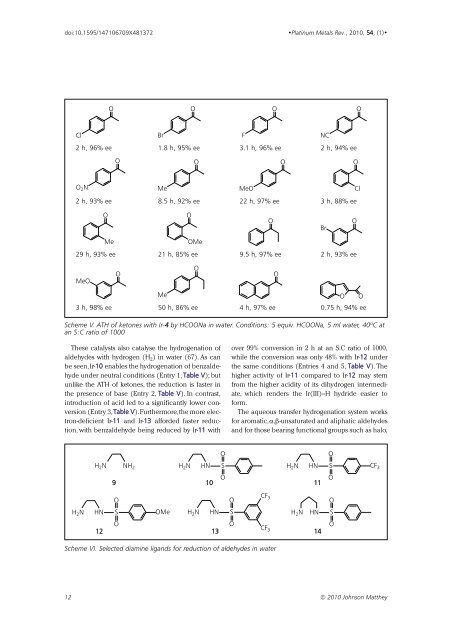Download Issue PDF - Platinum Metals Review
Download Issue PDF - Platinum Metals Review
Download Issue PDF - Platinum Metals Review
You also want an ePaper? Increase the reach of your titles
YUMPU automatically turns print PDFs into web optimized ePapers that Google loves.
doi:10.1595/147106709X481372<br />
•<strong>Platinum</strong> <strong>Metals</strong> Rev., 2010, 54, (1)•<br />
O<br />
O<br />
O<br />
O<br />
Cl<br />
Br<br />
F<br />
NC<br />
2 h, 96% ee 1.8 h, 95% ee 3.1 h, 96% ee 2 h, 94% ee<br />
O<br />
O<br />
O<br />
O<br />
O 2 N<br />
Me<br />
MeO<br />
Cl<br />
2 h, 93% ee 8.5 h, 92% ee 22 h, 97% ee 3 h, 88% ee<br />
O<br />
O<br />
O<br />
Br<br />
O<br />
Me<br />
OMe<br />
29 h, 93% ee 21 h, 85% ee 9.5 h, 97% ee 2 h, 93% ee<br />
MeO<br />
O<br />
O<br />
O<br />
Me O O<br />
3 h, 98% ee 50 h, 86% ee 4 h, 97% ee 0.75 h, 94% ee<br />
Scheme V. ATH of ketones with Ir-4 by HCOONa in water. Conditions: 5 equiv. HCOONa, 5 ml water, 40ºC at<br />
an S:C ratio of 1000<br />
These catalysts also catalyse the hydrogenation of<br />
aldehydes with hydrogen (H 2 ) in water (67). As can<br />
be seen,Ir-10 enables the hydrogenation of benzaldehyde<br />
under neutral conditions (Entry 1, Table V); but<br />
unlike the ATH of ketones, the reduction is faster in<br />
the presence of base (Entry 2, Table V). In contrast,<br />
introduction of acid led to a significantly lower conversion<br />
(Entry 3,Table V).Furthermore,the more electron-deficient<br />
Ir-11 and Ir-13 afforded faster reduction,<br />
with benzaldehyde being reduced by Ir-11 with<br />
over 99% conversion in 2 h at an S:C ratio of 1000,<br />
while the conversion was only 48% with Ir-12 under<br />
the same conditions (Entries 4 and 5, Table V). The<br />
higher activity of Ir-11 compared to Ir-12 may stem<br />
from the higher acidity of its dihydrogen intermediate,<br />
which renders the Ir(III)–H hydride easier to<br />
form.<br />
The aqueous transfer hydrogenation system works<br />
for aromatic,α,β-unsaturated and aliphatic aldehydes<br />
and for those bearing functional groups such as halo,<br />
O<br />
H 2 N NH 2 H 2 N HN S<br />
9<br />
10<br />
O<br />
O<br />
H 2 N HN S<br />
11<br />
O<br />
CF 3<br />
H 2 N HN<br />
O<br />
S<br />
O<br />
12<br />
OMe H 2 N HN<br />
O<br />
S<br />
O<br />
13<br />
CF 3<br />
O<br />
H 2 N HN S<br />
CF 3<br />
14<br />
O<br />
Scheme VI. Selected diamine ligands for reduction of aldehydes in water<br />
12 © 2010 Johnson Matthey
















